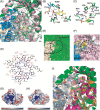Crystal structure of the apo form of a β-transaminase from Mesorhizobium sp. strain LUK
- PMID: 30805955
- PMCID: PMC6459997
- DOI: 10.1002/pro.3594
Crystal structure of the apo form of a β-transaminase from Mesorhizobium sp. strain LUK
Abstract
Pyridoxal 5'-phosphate (PLP)-dependent β-transaminases (βTAs) reversibly catalyze transamination reactions by recognizing amino groups linked to the β-carbon atoms of their substrates. Although several βTA structures have been determined as holo forms containing PLP, little is known about the effect of PLP on the conversion of the apo structure to the holo structure. We determined the crystal structure of the apo form of a βTA from Mesorhizobium sp. strain LUK at 2.2 Å resolution to elucidate how PLP affects the βTA structure. The structure revealed three major disordered regions near the active site. Structural comparison with the holo form also showed that the disordered regions in the apo form are ordered and partially adopt secondary structures in the holo form. These findings suggest that PLP incorporation into the active site contributes to the structural stability of the active site architecture, thereby forming the complete active site. Our results provide novel structural insights into the role of PLP in terms of active site formation.
Keywords: Mesorhizobium sp. strain LUK; apo form; disorder-to-order transition; pyridoxal 5′-phosphate; β-transaminase.
© 2019 The Protein Society.
Figures


Similar articles
-
Structural Consideration of the Working Mechanism of Fold Type I Transaminases From Eubacteria: Overt and Covert Movement.Comput Struct Biotechnol J. 2019 Jul 23;17:1031-1039. doi: 10.1016/j.csbj.2019.07.007. eCollection 2019. Comput Struct Biotechnol J. 2019. PMID: 31452855 Free PMC article. Review.
-
Crystal structures of the Chromobacterium violaceumω-transaminase reveal major structural rearrangements upon binding of coenzyme PLP.FEBS J. 2012 Mar;279(5):779-92. doi: 10.1111/j.1742-4658.2012.08468.x. Epub 2012 Jan 23. FEBS J. 2012. PMID: 22268978
-
Incorporation of pyridoxal-5'-phosphate into the apoenzyme: A structural study of D-amino acid transaminase from Haliscomenobacter hydrossis.Biochim Biophys Acta Proteins Proteom. 2025 Jan 1;1873(1):141056. doi: 10.1016/j.bbapap.2024.141056. Epub 2024 Oct 13. Biochim Biophys Acta Proteins Proteom. 2025. PMID: 39406293
-
Structural determinants of the β-selectivity of a bacterial aminotransferase.J Biol Chem. 2012 Aug 17;287(34):28495-502. doi: 10.1074/jbc.M112.375238. Epub 2012 Jun 28. J Biol Chem. 2012. PMID: 22745123 Free PMC article.
-
Stereospecificity for the hydrogen transfer and molecular evolution of pyridoxal enzymes.Biosci Biotechnol Biochem. 1996 Feb;60(2):181-7. doi: 10.1271/bbb.60.181. Biosci Biotechnol Biochem. 1996. PMID: 9063963 Review.
Cited by
-
Structural Consideration of the Working Mechanism of Fold Type I Transaminases From Eubacteria: Overt and Covert Movement.Comput Struct Biotechnol J. 2019 Jul 23;17:1031-1039. doi: 10.1016/j.csbj.2019.07.007. eCollection 2019. Comput Struct Biotechnol J. 2019. PMID: 31452855 Free PMC article. Review.
References
-
- Sugawara T, Tanaka A, Tanaka K, Nagai K, Suzuki K, Suzuki T (1998) YM‐170320, a novel lipopeptide antibiotic inducing morphological change of colonies in a mutant of Candida tropicalis pK233. J Antibiot (Tokyo) 51:435–438. - PubMed
-
- Nurbo J, Peterson SD, Dahl G, Danielson UH, Karlén A, Sandström A (2008) Beta‐amino acid substitutions and structure‐based CoMFA modeling of hepatitis C virus NS3 protease inhibitors. Bioorg Med Chem 16:5590–5605. - PubMed
-
- Miura K, Sawa T, Takeuchi T, Umezawa H (1986) Effects of enzyme‐inhibitors in inhibiting the growth and inducing the differentiation of human promyelocytic leukemia‐cells, HL‐60. J Antibiot (Tokyo) 39:734–735. - PubMed
Publication types
MeSH terms
Substances
LinkOut - more resources
Full Text Sources
Research Materials

